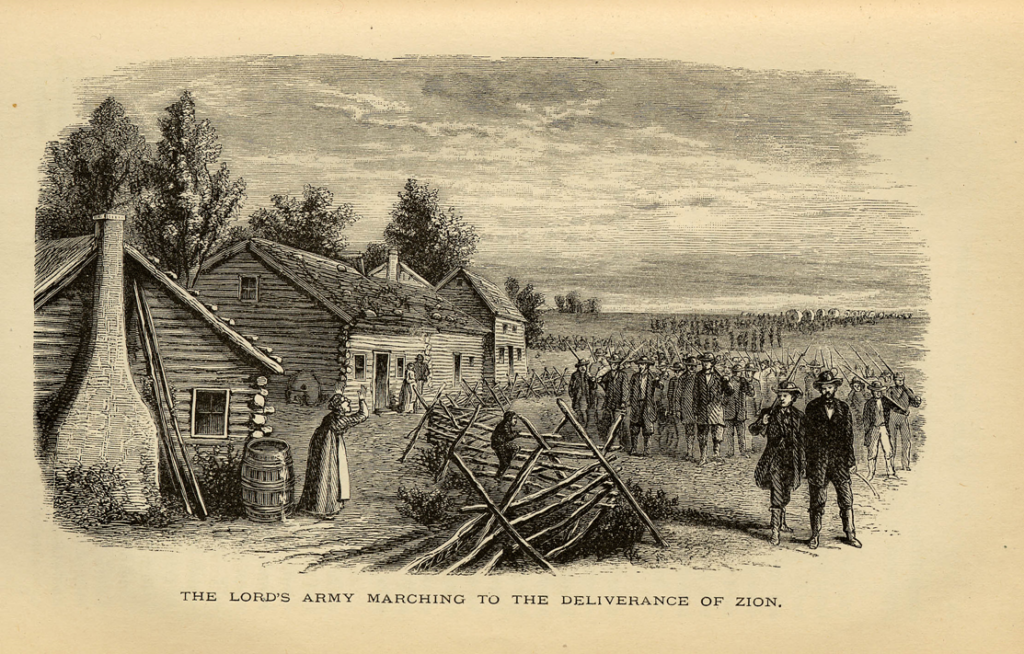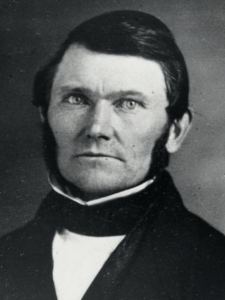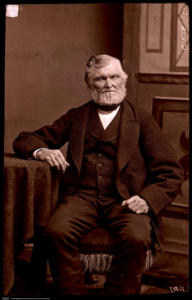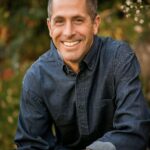by Matthew C. Godfrey
One of the seminal events of Wilford Woodruff’s life was his participation in the Camp of Israel (later known as Zion’s Camp) expedition in 1834. Wilford was recruited to participate in the camp after he had been a member of the Church for only a few weeks. The camp was the first time he got to meet individuals such as Joseph Smith, Brigham Young, and Heber C. Kimball, and it taught him several lessons. Wilford transmitted these lessons to the Saints throughout his life, and they are teachings that can benefit Church members today as well.

Zion’s Camp Overview
Zion’s Camp had its roots in the expulsion of the Saints from Jackson County, Missouri, in the fall of 1833. In late October and early November, Jackson County citizens organized and violently attacked settlements of the Saints in the county. Ultimately, members were forced to flee into surrounding counties, the majority of them going to Clay County. In January 1834, the Missouri Saints sent Parley P. Pratt and Lyman Wight to Kirtland, Ohio, to inform Joseph Smith and other Church leaders of their plight.
At the February high council meeting where Pratt and Wight spoke, Joseph Smith declared his intent of “going to Zion to assist in redeeming it” and then “called for volunteers to go with him.”1 That same day, a February 1834 revelation (section 103 in today’s Doctrine and Covenants) instructed Joseph to recruit up to five hundred men to go to the aid of Church members who had been expelled from Jackson County. The group would settle on land purchased in the county and vicinity and provide protection against any “enemies” that sought to drive the Saints from the “goodly land.”2
To fulfill these instructions, Joseph Smith and a contingent of men from Kirtland, Ohio, departed in May 1834; another contingent was recruited in Pontiac, Michigan Territory, by Hyrum Smith and Lyman Wight and joined the Kirtland group in June 1834 at the Allred settlement in Missouri. The camp totaled approximately 205 men and around twenty-five women and children. The march was at times grueling, with camp members walking as much as forty miles a day. Sometimes camp members did not have enough food or water, but for the most part, they had adequate provisions.
At other times, the expedition was threatened by individuals, most notably at Fishing River in Missouri where a storm prevented a mob from attacking the camp. At the end of June 1834, the camp was disbanded after a revelation stated that it was not yet time for Zion’s redemption (Section 105 in today’s Doctrine and Covenants). An outbreak of cholera hastened the camp’s dispersal and ended up killing thirteen participants and two other Church members.3 Joseph Smith led the expedition as the “Commander in Chief of the Armies of Israel.”4

Wilford Woodruff’s Experiences
When the Lord instructed Joseph Smith and other Church leaders to recruit individuals for Zion’s Camp, Wilford Woodruff had been a member of the Church for just a few weeks. Wilford was baptized near Richland, New York, where he was living, by Zera Pulsipher on December 31, 1833, at the age of twenty-six. About two months after Wilford’s baptism, Joseph Smith and Parley P. Pratt left Kirtland for the eastern United States to recruit men for the expedition. On March 19, 1834, they separated. Joseph Smith returned to Kirtland while Parley continued his efforts in New York.
One of the places Parley visited was Richfield. Here he met Wilford and Wilford’s brother Azmon. Parley told them about the proposed expedition to Missouri. According to Wilford, Parley said “it was the will of the Lord that the yong men & middle aged what could be spared should go up to Zion.”5 However, Azmon and Wilford had only recently purchased a farm in Richland, and they were concerned about leaving it just as spring was coming. Wilford expressed his concern to Parley, who responded that it was Wilford’s “duty to try to prepare [himself] and go up to Zion.”6 Wilford and Azmon were at a crossroads. Would they do what Parley said was God’s will or would they stay on their farm?
Wilford chose to go while Azmon chose to stay—and Wilford did not look back. “I used evry exertion,” he stated, “to settle my accounts arange my affairs and prepare myself to join my Brethren to go to Missourie.”7 He later remembered that after Parley had preached about the necessity of helping the Saints in Missouri, he knew that he had to go. “My feelings were such,” Wilford recalled, “that if all the gold in the world had been presented to me, I could not have been hired to stay at home.”8
Having made the decision to go, Wilford traveled with Harry Brown and Warren Ingalls to Kirtland, where they arrived on the night of April 25. “There,” Wilford declared, “for the first time I had a view of our beloved Brother Joseph Smith the Prophet & Seer which God hath raised up in these last days through whom the saints receieve Revelations from time to time.”9 Wilford’s opinion of Joseph only increased as he became better acquainted with him—something that happened easily since Wilford stayed with Joseph the week he was in Kirtland.
On May 1, 1834, Wilford left with the first company of the expedition, consisting of about twenty men and four baggage wagons, one of which was Wilford’s. They traveled to New Portage, Ohio, that first day, where they waited for the rest of the group to join them a few days later. Then the expedition set out across Ohio for Missouri.
While on the journey, Wilford experienced all of the hardships and good times of Zion’s Camp, including the long days of walking, the cholera outbreak, the uncovering of a skeleton in a burial mound that became known as Zelph, and the Fishing River storm.10 He considered his experiences as important to his spiritual growth and tried to educate the Saints about Zion’s Camp for the rest of his life.
One of the Church’s most diligent recordkeepers in the nineteenth century, Wilford provided several accounts of Zion’s Camp. One account came in his journal. This was not something he kept contemporaneously while he was on the expedition, but he wrote a summary of his experiences probably in late 1834 or early 1835, although he inserted some details later than that. This account provides some good details about the camp, especially about the cholera epidemic.11

In 1882, Wilford composed a history of the expedition titled “The History and Travels of Zion’s Camp,” based on several sources, including the manuscript history of the Church and his own memory and writings. This 124-page manuscript, written from Joseph Smith’s perspective, contains a daily account of the expedition’s travels, as well as copies of pertinent correspondence.12 Wilford also occasionally related episodes from Zion’s Camp in his discourses to the Saints. A few of these appear in Journal of Discourses. Many of these recollections focused on how the expedition allowed Wilford to interact with Joseph Smith. These interactions convinced him that Joseph was a prophet of God.
Another account came in Leaves from My Journal, the third installment of George Q. Cannon’s “Faith Promoting Series.” Cannon published Leaves from My Journal in 1882. It was a condensed version of Wilford’s autobiographical writings from the 1850s and 1860s and contained examples of Wilford listening to the Spirit throughout his life, as well as his testimony of the Restored Gospel. This history contains several stories about Wilford’s experiences in Zion’s Camp, including details about his impressions of Joseph Smith.13
In all of these accounts, Wilford portrayed Zion’s Camp as one of the most important events in his life pertaining to his spiritual growth. He came to know that God was with the Saints just as he had been with the children of Israel in Old Testament times. He saw the Lord intervening on behalf of the camp. His experiences clearly solidified Wilford’s testimony of the Restored Gospel. “Had I not gone up with Zion’s Camp,” he once declared at a time when he was a member of the Quorum of the Twelve Apostles, “I should not have been here today.”14
Lessons from Wilford’s Experiences with Zion’s Camp
Wilford learned many lessons from his time in Zion’s Camp. One of these is that the Saints in the latter days were not that different from the children of Israel in the Old Testament. In some of his accounts, Wilford compared Zion’s Camp to the children of Israel’s exodus from Egypt. For example, after the expedition reached New Portage, Ohio, and set up camp, Wilford “went to the top of the hill and looked down upon the camp of Israel.” After praying on the hill, “I rejoiced and praised the Lord that I had lived to see some of the tents of Israel pitched, and a company gathered by the commandment of God to go up and help redeem Zion.”15
Wilford also equated the Fishing River storm to the Lord destroying the armies of Pharaoh in the Red Sea. “The Lord delivered Israel in the days of Moses by dividing the Red Sea, so they went over dry shod,” he explained. “The Lord delivered Zion’s Camp from their enemies on the 19th of June, 1834, by piling up the waters in Fishing River forty feet in one night, so our enemies could not cross. He also sent a great hail-storm which broke them up and sent them seeking for shelter.”16
In addition, Wilford believed that Zion’s Camp was similar to the journeys of Book of Mormon peoples, specifically the Jaredites. “Every night before retireing to rest,” he explained in his history of Zion’s Camp, “at the sound of the trumpet we bowed before the Lord, in the several tents; and presented our thank and offerings with prayer and supplications.” Each morning, he stated, “every man was again on his knees before the Lord, imploring his blessings for the day.” In this way, he declared, “our journey was like the ancient Jaredites pitching our tents by the way.”17
Wilford’s connection of the camp with ancient Israel and the Jaredites showed him that we are all the covenant children of God, who interacts with us in the same ways that he interacted with the children of Israel or Book of Mormon peoples. This gave Wilford—and can give us—the confidence that we are just as important in the Lord’s eyes as those people of scripture were. And the events of our lives can be as significant for those who follow as the accounts of God’s people in the scriptures are for us today.
Wilford also learned about the necessity of sacrifice in developing spirituality through his Zion’s Camp experiences. His willingness to leave his and his brother’s farm behind to do his duty to the Lord was one example of this sacrifice—and it had a great impact on Wilford’s life. It is interesting to think about why Wilford became one of the Church’s great leaders—even the prophet of God—while his brother Azmon struggled with his testimony for much of his life. There are certainly many reasons for this—matters of faith are complicated things—but Wilford’s willingness to sacrifice for the Gospel, expressed early in his Church membership, was one factor.18
While on the expedition, Wilford had other experiences that taught him the importance of sacrifice. One of these came after the cholera epidemic broke out among camp members. When the expedition arrived in Clay County, Missouri, Wilford and his group went to the residence of Church member John Burk. He had an extra room in his house that he said Wilford’s company could have if they would clean it. “Fearing some other company would get it first,” Wilford remembered, the group “left all other business and went to work, cleaning out the room, and immediately spread down our blankets, so as to hold a right to the room.” However, not long after, several men suffering from cholera “were brought in and laid upon our beds. None of us ever used those blankets again, for they were buried with the dead.” Wilford concluded, “We gained nothing but experience by being selfish, and we lost our bedding.”19
Wilford then explained the lesson that he learned from this, one that he believed was especially important to youth: “Whenever you are blessed with any good thing, be willing to share it with others. By cultivating these principles while you are young, you will lay a foundation to do much good through your lives, and you will be beloved and respected of the Lord and all good men.”20
Another key lesson Wilford learned from Zion’s Camp was how much God was interested in His life. There were several examples of divine intervention throughout the expedition, but none more pronounced than what happened to the group at Fishing River. While the expedition was camped there, a small contingent of men threatened that the Saints would “see hell enough before morning.” After the men left, “a small black cloud appeared in the northwest and it began to unroll itself like a scroll.” In just a few minutes, Wilford stated, “the whole heavens were covered with a pall as black as ink,” and a gigantic thunderstorm hit “with wind, rain, thunder, lightning and hail.” Observing the storm, Joseph Smith, according to Wilford, declared, “Boys, there is some meaning in this—God is in the storm.”
The rain and hail, together with a drastic rise in the river, prevented any mob from attacking the camp. “It was reported,” Wilford related, “that the Captain of the company” hoping to fight the expedition “said that it was a d—d strange thing that they could do nothing against the d—d Mormons but what there must be a d—d hail storm or some other d—d thing to hinder them from doing anything.” Yet, Wilford continued, the captain “did not feel disposed to acknowledge that God was fighting our battles.”21 To Wilford, that lesson was obvious—God was with the camp and helped it in its time of need. God’s interest in the camp—and in Wilford personally—was a great lesson that remained with Wilford for the rest of his life.
Wilford was also grateful that Zion’s Camp allowed him to interact with Joseph Smith and observe the Prophet closely. For a recently baptized member, this deepened his testimony of Joseph as a prophet. “I went up to Missouri in Zion’s Camp; I saw the Prophet every day, and I knew he was a Prophet of God,” he stated to a group of Saints in Salt Lake City, Utah, in 1862.22 On another occasion, he explained that Zion’s Camp provided him with “an experience that we never could have gained in any other way.” He continued, “We had the privilege of beholding the face of the prophet, and we had the privilege of traveling a thousand miles with him, and seeing the workings of the Spirit of God with him, and the revelations of Jesus Christ unto him and the fulfillment of those revelations.”23
Wilford concluded that Zion’s Camp showed him that in Joseph’s “public and private career he carried with him the Spirit of the Almighty.” Indeed, Joseph “manifested a greatness of soul which I had never seen in any other man.”24 We may not have the opportunity to interact with the Prophet every day like Wilford, but we can observe his teachings and see “the workings of the Spirit of God with him.” As we do so, our testimonies of the prophet can deepen just as Wilford’s did.
Finally, Wilford’s experiences with Zion’s Camp—and his careful chronicling of them—teaches us the importance of keeping records. We can benefit spiritually from Wilford’s accounts of the expedition because he was willing to keep such records. It is sometimes difficult to find the time to write in a journal or compose a brief history of our lives, but doing so will bless the lives of those who follow. In 2007, President Henry B. Eyring counseled Church members to “find a way” to preserve experiences that demonstrated God’s love and His hand in our lives. These would then become cherished records to buoy us up when we “need to remember how much God loves us and how much we need Him.”25
Wilford found a way to record his experiences, and if we can also find a way, our experiences can have just as much of a spiritual impact on those who follow as Wilford’s have on us. We can be a blessing and strength to those that come after us as well.
Endnotes
- Minutes, February 24, 1834, josephsmithpapers.org/minutes/1834-02-24.
- Revelation, February 24, 1834 [D&C 103:20, 24–26], josephsmithpapers.org/revelation/1834-02-24.
- Matthew C. Godfrey, “‘The Redemption of Zion Must Needs Come by Power’: Insights into the Camp of Israel Expedition, 1834,” BYU Studies Quarterly 53, no. 4 (2014): 126–127.
- Minutes, February 24, 1834, josephsmithpapers.org/minutes/1834-02-24.
- Wilford Woodruff’s Journal, April 11, 1834, Wilford Woodruff Papers, wilfordwoodruffpapers.org/journal/1834-04-11.
- Wilford Woodruff’s Journal, April 11, 1834, Wilford Woodruff Papers, wilfordwoodruffpapers.org/journal/1834-04-11.
- Wilford Woodruff’s Journal, April 11, 1834, Wilford Woodruff Papers, wilfordwoodruffpapers.org/journal/1834-04-11.
- Wilford Woodruff, “Early Events of the Church, Etc.,” Journal of Discourses 7:98.
- Wilford Woodruff’s Journal, April 25, 1834, Wilford Woodruff Papers, wilfordwoodruffpapers.org/journal/1834-04-25.
- For more information about the expedition’s travels, see Matthew C. Godfrey, “The Camp of Israel’s March to Missouri,” in Zion’s Camp, 1834: March of Faith, ed. Matthew C. Godfrey (Sandy, UT: History of the Saints, 2018), 33–65, and Alexander L. Baugh, “The Camp of Israel in Clay County, Missouri,” in ibid., 67–101.
- Wilford Woodruff’s Journal, p. 1, Wilford Woodruff Papers, wilfordwoodruffpapers.org/journal.
- “History – The History of Zion’s Camp,” p. 1, Wilford Woodruff Papers, wilfordwoodruffpapers.org/the-history-of-zions-camp.
- “Leaves From My Journal,” p. 1, Wilford Woodruff Papers, wilfordwoodruffpapers.org/leaves-from-my-journal.
- Wilford Woodruff, “The Holy Ghost—Laboring in Faith—The Kingdom of God—Patriarchal Marriage,” Journal of Discourses 13:156.
- “Leaves From My Journal,” p. 17, Wilford Woodruff Papers, wilfordwoodruffpapers.org/leaves-from-my-journal.
- “Leaves From My Journal,” p. 18, Wilford Woodruff Papers, wilfordwoodruffpapers.org/leaves-from-my-journal.
- “History – The History of Zion’s Camp,” p. 7, Wilford Woodruff Papers, wilfordwoodruffpapers.org/the-history-of-zions-camp.
- Thomas G. Alexander explores this question—as well as Wilford’s experiences in Zion’s Camp—in his excellent article “Wilford Woodruff and Zion’s Camp: Baptism by Fire and the Spiritual Confirmation of a Future Prophet,” BYU Studies 39, no. 1 (2000): 130–146.
- “Leaves From My Journal,” p. 18, Wilford Woodruff Papers, wilfordwoodruffpapers.org/leaves-from-my-journal.
- “Leaves From My Journal,” p. 19, Wilford Woodruff Papers, wilfordwoodruffpapers.org/leaves-from-my-journal.
- “History – The History of Zion’s Camp,” pp. 62–64, Wilford Woodruff Papers, wilfordwoodruffpapers.org/the-history-of-zions-camp.
- Wilford Woodruff, “Fulfilment of Prophecy—Power of the Gospel—Consistency of Its Principles,” Journal of Discourses 10:9.
- Wilford Woodruff, “The Holy Ghost—Laboring in Faith—The Kingdom of God—Patriarchal Marriage,” Journal of Discourses 13:162.
- Wilford Woodruff, “Early Events of the Church,” Journal of Discourses 7:98.
- President Henry B. Eyring, “O Remember, Remember,” Ensign, ChurchofJesusChrist.org/ensign.
 Matthew C. Godfrey is a general editor of the Joseph Smith Papers and senior managing historian for outreach and engagement with the Church History Department. He holds a PhD in American and public history from Washington State University. He previously served as managing historian of the Joseph Smith Papers and was the lead historian on three volumes of the Documents series. He has authored or coedited several books and articles, including Religion, Politics, and Sugar: The Mormon Church, the Federal Government, and the Utah-Idaho Sugar Company, 1907–1921 (2007); The Earth Shall Appear as the Garden of Eden: Essays in Mormon Environmental History (2018); Zion’s Camp 1834: March of Faith (2018); and Know Brother Joseph: New Perspectives on Joseph Smith’s Life and Character (2019). He serves as an Advisor to the Wilford Woodruff Papers Project.
Matthew C. Godfrey is a general editor of the Joseph Smith Papers and senior managing historian for outreach and engagement with the Church History Department. He holds a PhD in American and public history from Washington State University. He previously served as managing historian of the Joseph Smith Papers and was the lead historian on three volumes of the Documents series. He has authored or coedited several books and articles, including Religion, Politics, and Sugar: The Mormon Church, the Federal Government, and the Utah-Idaho Sugar Company, 1907–1921 (2007); The Earth Shall Appear as the Garden of Eden: Essays in Mormon Environmental History (2018); Zion’s Camp 1834: March of Faith (2018); and Know Brother Joseph: New Perspectives on Joseph Smith’s Life and Character (2019). He serves as an Advisor to the Wilford Woodruff Papers Project.
The mission of the Wilford Woodruff Papers Foundation is to digitally preserve and publish Wilford Woodruff’s eyewitness account of the Restoration of the gospel of Jesus Christ. Thousands of transcribed pages are available at wilfordwoodruffpapers.org/documents, including Wilford’s journals, missionary records, dreams and visions, autobiographies, and histories.
The post Sacrifice and Obedience: Lessons from Zion’s Camp appeared first on FAIR.
Continue reading at the original source →



